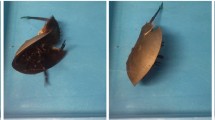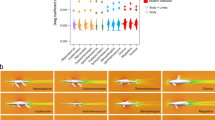Abstract
We have modified our equations of motion for sinking Nautilusshells to a more general form suitable for application to fossil cephalopods. The new equations incorporate the effects of hydrodynamic stability and loss of buoyancy due either to the unrestricted entry of water into the shell during sinking, or to entry by diffusion across the wall of the siphuncular tube. With our new equations it is possible to calculate sinking velocity and pressure across the shell wall as a function of depth for shells of any size and shape. Our system provides a means of analyzing several aspects of the post-mortem history of cephalopod shells including vertical preservation. In the latter case, our equations enable us to find water depth from the geometry of a vertically preserved shell. We calculate the maximum water depth of the Hauptmuschelkalk beds (Triassic, south-central Germany) to have been about 3 m. Our method is unique in providing a way of obtaining numerical values for maximum water depth of ancient sediments and sedimentary environments. These equations also offer the possibility of examining the paleoecology and paleobiology of the living animals, especially with respect to swimming ability and vertical migration.
Similar content being viewed by others
References
Chamberlain, J. A., Jr., 1976, Flow patterns and drag coefficients of cephalopod shells: Palaeontology, v. 19, p. 539–563.
Chamberlain, J. A., Jr. 1978, Permeability of the siphuncular tube ofNautilus: its ecologic and paleoecologic implications: Neues Jahrb. Geol. Paläont. Mh. p. 129–142.
Chamberlain, J. A., Jr., and Weaver, J. S., 1974, Sinking kinematics of nekroplanktonic cephalopod shells: Geol. Soc. Amer. Abstr. Program Annu. Meet., v. 6, p. 685–686.
Chamberlain, J. A., Jr., and Weaver, J. S., in preparation, Paleoenvironmental significance of vertically preserved cephalopod shells.
Collins, D. H., and Minton, P., 1967, Siphuncular tube ofNautilus: Nature, v. 216, p. 916–917.
Geisler, R., 1938, Zur Stratigraphie des Hauptmuschelkalks in der Unbegung von Würzburg mit besonderer Berücksichtigung der Ceratiten: Jahrb. Preuss. Geol. Landenstalt, v. 59, p. 197–248.
Kennedy, W. J., and Cobban, W. A., 1976, Aspects of ammonite biology, biogeography, and biostratigraphy. Paleont. Assoc., Spec. Papers Palaeont., no. 17, 94 pp.
Mutvei, H., and Reyment, R., 1973. Buoyancy control and siphuncle function in ammonoids: Palaeontology, v. 16, p. 623–636.
Raup, D. M., 1967, Geometric analysis of shell coiling: coiling in ammonoids: Jour. Paleont., v. 41, p. 43–65.
Raup, D. M., 1973, Depth inferences from vertically imbedded cephalopods: Lethaia, v. 6, p. 217–226.
Raup, D. M., and Chamberlain, J. A., Jr., 1967, Equations for volume and center of gravity in ammonoid shells: Jour. Paleont., v. 41, p. 566–574.
Reyment, R., 1958, Some factors in the distribution of fossil cephalopods: Stockh. Contrib. Geol., v. 1, p. 97–184.
Reyment, R., 1968. Orthoconic nautiloids as indicators of shoreline surface currents: Jour. Sed. Petrol., v. 38, p. 1398–1389.
Reyment, R. A., 1970, Vertically inbedded cephalpod shells. Some factors in the distribution of fossil cephalopods, 2, Palaeogeo. Palaeoclim. Palaeoecol., v. 7, p. 103–111.
Reyment, R., 1973. Factors in the distribution of fossil cephalopods, 3. Experiments with exact shell models of certain shell types: Bull. Geol. Inst. Univ. Upps., N. S. 4, part 2, p. 7–41.
Saunders, W. B., and Wehman, D. A., 1977, Shell strength ofNautilus as a depth limiting factor: Paleobiology, v. 3, p. 83–89.
Seilacher, A., 1971, Preservational history of ceratite shells: Palaeontology, v. 14, p. 16–21.
Stenzel, H. B., 1964, LivingNautilus: in Treatise on Invertebrate Paleontology, R. C. Moore, Ed., Part K, Mollusca 4, Univ. Kansas Press, Lawrence, p. K59-K93.
Teichert, C., 1970. DriftedNautilus shells in the Bay of Bengal: Jour. Paleont., v. 44, p. 1129–1130.
Trueman, A. E., 1941, The ammonite body-chamber, with special reference to the buoyancy and mode of life of the living ammonite: Quart. Jour. Geol. Soc. London, v. 96, p. 339–383.
Vossmerbäumer, H., 1972, Cephalopoden in Muschelkalk Mainfrankens. Ein biostratinomischer Beitrag, Geol. Bl. Nordost., v. 22, p. 8–22.
Weaver, J. S., and Chamberlain, J. A., Jr., 1976. Equations of motion for postmortem sinking of cephalopod shells and the sinking ofNautilus: Paleobiology, v. 2, p. 8–18.
Author information
Authors and Affiliations
Rights and permissions
About this article
Cite this article
Chamberlain, J.A., Weaver, J.S. Equations of motion for post-mortem sinking of cephalopod shells. Mathematical Geology 10, 673–689 (1978). https://doi.org/10.1007/BF01031898
Received:
Revised:
Issue Date:
DOI: https://doi.org/10.1007/BF01031898




